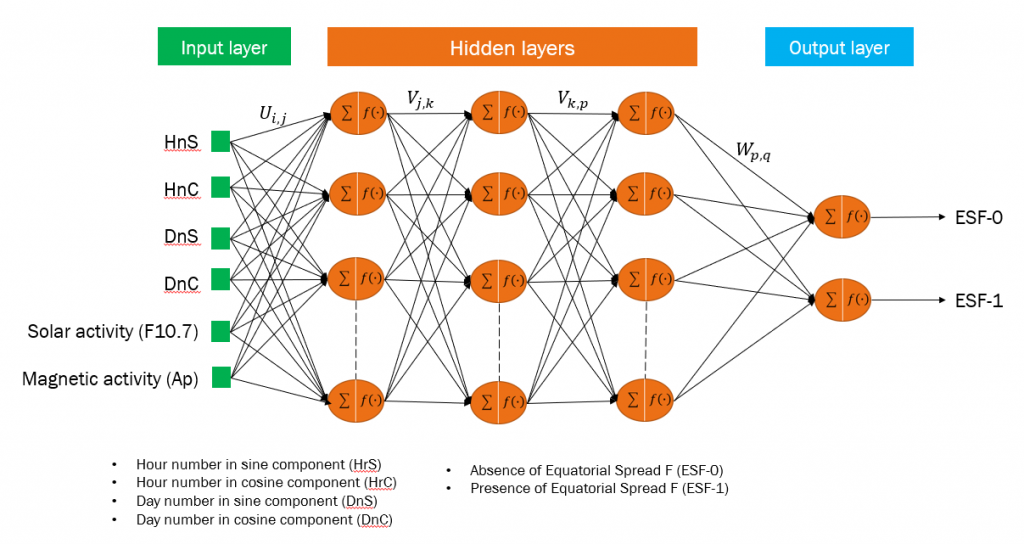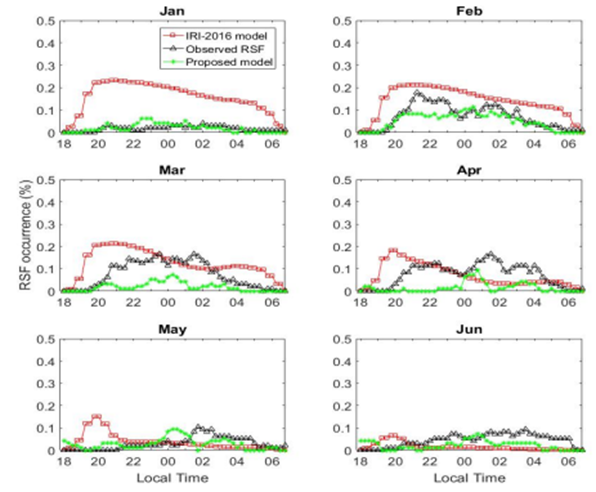Motivation
The ionosphere is a layer of the Earth’s atmosphere layers that plays a significant role in the radio wave propagation systems because it contains the high plasma density more than others. The variability of the density is triggered by various factors such as solar activity, magnetic activity, and ionospheric conditions. The variability in the ionosphere leads to the ionospheric irregularities with numerous levels, i.e., weak, moderate, and severe levels. The ionospheric irregularities generally occur over all regions around the world but often in equatorial, low-latitude, and high-latitude regions, particularly. The occurrence of these ionospheric irregularities can affect the communication systems satellite communications, and navigation systems severely, leading to the loss of the human life being. For example, the outage of ultra-high frequency (UHF) communications (Kelly et al., 2014) and the scintillation of satellite navigation signals degraded positioning accuracy (Shi et al., 2011; Spogli et al., 2016). One of the ionospheric irregularities at nighttime near the magnetic equator is so-called equatorial ionospheric irregularity. This irregularity can be observed by instruments such as Ionosondes, GPS satellites, all sky imagers, very high frequency (VHF) radar, low earth orbit satellites Swarm, and Cosmic satellites (Olugbo et al., 2020; Nishioka et al., 2008; Otsuka et al., 2018; Sekar et al., 2004; Zakharenkova et al., 2016; Ko and Yeh, 2010). Some researchers have attempted an effort of applying the mathematical methods in forecasting this irregularity event, i.e., (Abdu et al., 2003) utilized the Cubic-B spline method to develop the prediction model of the ionospheric spread F occurrence in Brazil, (Anderson et al., 2017) found the threshold by considering the relationship between total hourly mean S4 index (THMS4) and the F-layer height (h’F) variations for predicting the ionospheric spread F in Peru and Brazil, etc. Thus, the monitoring and understanding of the ionospheric irregularities are essential processes in space weather study, and the forecasting model is also a very important tool to help the predictability of the ionospheric irregularities.
Objectives and Methodology
To be aware of the equatorial ionospheric irregularities, this work aims to study the equatorial ionospheric irregularities by ionospheric parameters such as the equatorial ionospheric spread F (ESFs) irregularities, the virtual height of the bottom-side ionospheric F layer (h’F), the critical frequency of the ionospheric F2 layer (foF2) and the S4 scintillation index. All these ionospheric parameters are obtained from the frequency modulated continuous waves (FMCW) ionosonde and GPS receiver at Chumphon station (10.7°N, 99.4°E; geomagnetic latitude: 3.0°N), Thailand. Furthermore, this work utilizes Artificial Intelligence (AI) including artificial neural networks (ANNs), recurrent neural networks (RNNs), and long short-term memory (LSTM) to develop the forecasting model for the equatorial ionospheric spread F irregularities. As widely known that the equatorial ionospheric spread F irregularities are associated with the equatorial plasma bubbles (EPBs) phenomena. Therefore, the capability of this forecasting model will be very useful for predicting the occurrence of the EPBs as well. The results of this work will be compared with the international reference ionosphere (IRI) model.
Novelty: (Ionosonde data, GPS data, Deep Neural Networks)

Key Results
From the analysis of the equatorial spread-F occurrence, we found that the equatorial spread F occurrence percentage in March, April, September, and October in 2014 from the observations varies following the time and seasonal variations. Furthermore, we noticed that the estimations of the IRI-model deviate from the real observed results at CPN station as demonstrated in Fig. 1.

Fig. 1. Comparison of equatorial spread-F occurrence percentage between observations and estimations of the IRI model in (a). March, (b). April, (c). September and (d). October in 2014 at CPN station, Thailand.
The comparison results of range type of the equatorial spread-F (RSF) occurrence percentage from January to June in 2016 are shown in Fig. 2. The result represents the ability of proposed model as Artificial Neural Network (ANN) and the IRI-model compared to the observations at CPN station. The predictability of the models is very challenge for the high accuracy prediction due to the complexes of the equatorial ionospheric spread F irregularities.

Fig. 2. Comparison of the range type of spread F occurrence percentage between observations, proposed model (ANN model) and the IRI-2016 model in January to June in 2016 at CPN station, Thailand.
References:
- Abdu, M., Souza, J., Batista, I. & Sobral, J., 2003. Equatorial spread-F statistics and empirical representation for IRI: a regional model for the Brazilian longitude sector. Advance in Space Research, 31(3), pp. 703-716.
- Anderson, D. N., and Redmon, R. J., 2017. Forecasting scintillation activity and equatorial spread F. Space Weather, 15, pp. 495-502.
- Ko, C. & Yeh, H., 2010. Cosmic/formosat-3 observations of equatorial F region irregularities in the SAA longitude sector. Journal of Geophysical Research, Volume 115, pp. 1-16.
- Kelly, M., Combereate, J., E.S., M. & Paxton, L., 2014. Progress toward forecasting of space weather effects on UHF SATCOM after Operation Anaconda. Space Weather, Volume 12, pp. 601-611.
- Nishioka, M., Saito, A. & Tsugawa, T., 2008. Occurrence characteristics of plasma bubble derived from global ground-based receiver networks. Volume 113, pp. 1-12.
- Olugbon, B. et al., 2020. Daytime equatorial spread F-like irregularities detected by HF Droppler receiver and Digisonde. Space Weather, 22 03.Volume 19.
- Otsuka, Y., 2018. Review of the generation mechanisms of post-midnight irregularities in the equatorial and low-latitude ionosphere. Progress in Earth and Planetary Science, Volume 25, pp. 1-13.
- Reinisch, B. W. et al., 2004. Multistation digisonde observations of equatorial spread F in South America. Annales Geophysicae, Volume 22, pp. 3145-3153.
- Sekar, R. et al., 2004. Characterization of VHF radar observations associated with equatorial spread F by narrow-band optical measurement. Volume 22, pp. 3129-3136.
- Spogli, L. et al., 2016. Formation of ionospheric irregularities over Southeast Asia during the 2015 St. Patrick’s Day storm. J. Geophys. Res. Space Physics, Volume 121, pp. 12211-12233.
- Shi, J. et al., 2011. Relation between strong range spread F and ionospheric scintillations observed in Hainan from 2003 to 2007. J. Geophys. Res. Sp. Phys., Volume 116, pp. 1-5.
-
Zakharenkova, I., Astafyeva, E. & Cherniak, I., 2016. GPS and In-situ swarm observations of the equatorial plasma density irregularities in the top side ionosphere. Earth, Planets and Space, Volume 68:120, pp. 1-12.